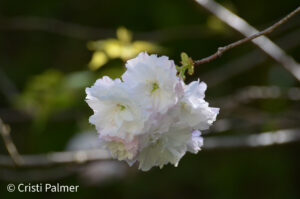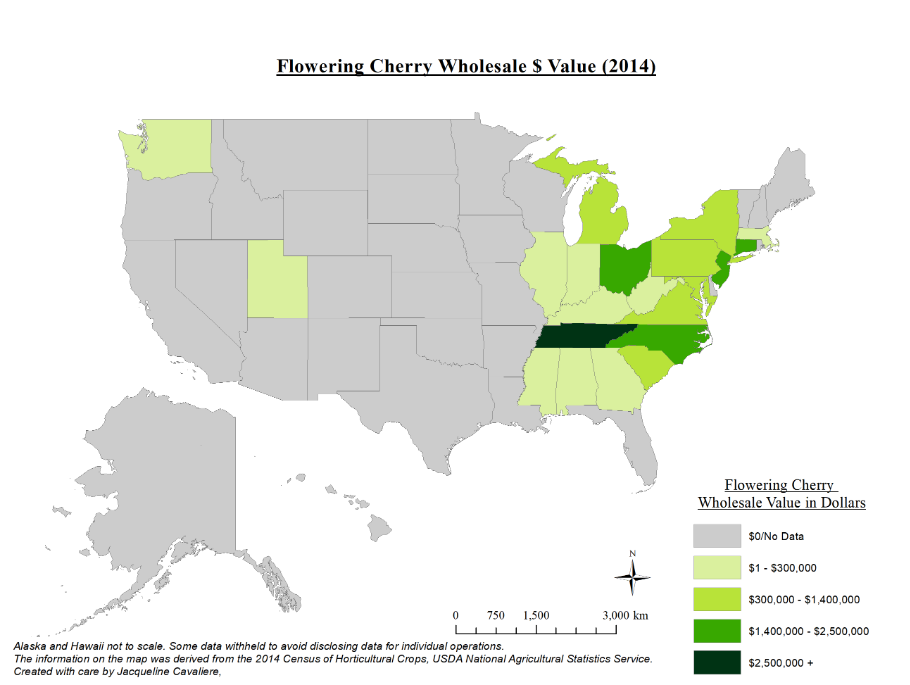Plant Information
 Ornamental flowering cherries belong to the genus Prunus in the rose family Rosacea, consisting primarily of species native to Asia. The majority of the flowering species are native to Japan and Korea, where centuries of propagation and cultivation have led to the selection of hundreds of genotypes. The most well-known ornamental cherry is the Japanese cherry Prunus serrulata, which are widely distributed in Japan, Taiwan, Korea, Mainland China, Thailand, Nepal, India, Pakistan, Afghanistan, Iran, Myanmar, Europe, United States, Canada, and West Siberia. Despite the popularity of flowering cherry trees in the landscape, most ornamental Prunus planted in the United States are derived from a limited genetic base of Japanese flowering cherry taxa. The most widely cultivated flowering cherry trees planted in the United States represent only a few species, primarily P. serrulata, P. subhirtella, and P. x yedoensis. A diverse collection of ornamental Prunus germplasm is maintained at the US National Arboretum (USNA) as part of an ongoing flowering cherry improvement program, but the genetic backgrounds of many trees are unclear. The USNA has an ongoing breeding program aimed at broadening this base by developing new cultivars of ornamental cherry with disease and pest resistance, tolerance to environmental stresses, and superior ornamental characteristics.
Ornamental flowering cherries belong to the genus Prunus in the rose family Rosacea, consisting primarily of species native to Asia. The majority of the flowering species are native to Japan and Korea, where centuries of propagation and cultivation have led to the selection of hundreds of genotypes. The most well-known ornamental cherry is the Japanese cherry Prunus serrulata, which are widely distributed in Japan, Taiwan, Korea, Mainland China, Thailand, Nepal, India, Pakistan, Afghanistan, Iran, Myanmar, Europe, United States, Canada, and West Siberia. Despite the popularity of flowering cherry trees in the landscape, most ornamental Prunus planted in the United States are derived from a limited genetic base of Japanese flowering cherry taxa. The most widely cultivated flowering cherry trees planted in the United States represent only a few species, primarily P. serrulata, P. subhirtella, and P. x yedoensis. A diverse collection of ornamental Prunus germplasm is maintained at the US National Arboretum (USNA) as part of an ongoing flowering cherry improvement program, but the genetic backgrounds of many trees are unclear. The USNA has an ongoing breeding program aimed at broadening this base by developing new cultivars of ornamental cherry with disease and pest resistance, tolerance to environmental stresses, and superior ornamental characteristics.
Ornamental flowering cherries have become very popular plants for street, commercial, and residential landscapes in the United Sates since the historic Tidal Basin cherries were planted in our nation’s capital Washington, DC in 1912. Most of these Prunus species, along with their cultivars, came from Japan. In 1862, George Roger Hall, noted as one of the first to introduce Japanese cherry trees into the US, brought in 15 varieties, and in 1876 Dr. William S. Clark began to introduce wild species of Prunus sargentii (Sargent Cherry). Japanese flowering cherries are the most widely adapted and popular flowering tree growing in the United States today. The multi-colored flowers of the Yoshino Cherry, P. x yodoensis, and Kwanzan Cherry (P. serrulata) are seen early in the season, and the buds open into clusters of abundant, long-lasting flowers that dominate the landscape of Washington, D.C. Other popular ornamental cherries include Akebono, Autumn Flowering Cherry, Weeping Cherry, Sargent Cherry, Fugenzo Cherry, Okame Cherry, and Shirofugen Cherry.
Ornamental cherry trees are known for their explosion of showy flowers in the spring. The showy flowers may be white or pink, single or double; some are fragrant. Double-flowered varieties tend to hold their bloom longer. Flowers occur before or with the leaves. The new leaves are often bronze when unfolding, turning deep green in summer, then red, purple, or even yellow-orange in autumn. Fruit is seldom produced. On average, ornamental cherry trees live between 15 and 20 years, but some varieties can survive longer with the correct care.
Ornamental cherry trees are mainly used as lawn specimens, street trees, and groupings. Wide, spreading trees work well as shade trees, while smaller ones enhance a small garden area. They can be grown in USDA zones 5-8 or 5-9 in the West. When choosing a tree, be sure to select one that is recommended for your zone. Trees should be planted in full sun in well-drained soil and protected from strong winds. They do well in almost any soil type or pH provided the soil is well-drained and moist. Plant ornamental cherries in the early fall. They do very well in the home garden, as their care is nominal. Water them thoroughly after planting and until the tree has established. Prune to thin out branches and improve air and light circulation as well as to remove any dead or diseased branches. Apply fertilizer regularly and be consistent with irrigation to minimize stress on the tree which can encourage pests and diseases. Treat any pests and diseases with the application of recommended products.
Economics
According to the USDA NASS Census of Horticulture, flowering cherry trees sold for a wholesale value of $33.9M in 2019 and $29.7M in 2014.

Main Disease Problems
Ornamental cherries have several main disease problems including leaf spot, black knot, silver leaf, powdery mildew, brown rot, Leucostoma canker, root rot, fireblight, rust, and necrotic ring spot.
Main Pest Problems
Ornamental cherries have a variety of pests including aphids, caterpillars, beetles and borers, leafhoppers, San Jose scale, spider mites, and cherry slug.
IR-4 Research
IR-4 has sponsored 5 crop safety trials with 4 products, and we have screened 14 new actives with ornamental cherries for effective management of adult Japanese beetles (Popillia japonica) and ambrosia beetles (Xylosandrus crassiusculus).
Sources Cited
https://journals.ashs.org/jashs/view/journals/jashs/134/4/article-p435.xml
https://www.newworldencyclopedia.org/entry/Cherry
https://en.wikipedia.org/wiki/Cherry
https://www.nps.gov/subjects/cherryblossom/history-of-the-cherry-trees.htm
https://blogs.loc.gov/inside_adams/2012/03/field-of-cherries/
https://www.tytyga.com/History-of-the-Cherry-Tree-a/379.htm
https://forums.botanicalgarden.ubc.ca/threads/the-origins-of-japanese-cherry-species.94977/
https://www.gardenia.net/guide/which-flowering-cherry-tree-for-my-garden
https://homeguides.sfgate.com/cherry-trees-insects-cause-leaf-damage-58153.html
https://www.treehelp.com/cherry-insects-diseases/
https://extension.psu.edu/ornamental-cherry-diseases
https://www.savatree.com/cherry-tree.html
USDA-NASS Census of Horticulture, 2018 and 2014
Authors
Ely Vea, IR-4 Environmental Horticulture Program Assistant Manager and Jacqueline Cavaliere, IR-4 Environmental Horticulture Program Coordinator.


